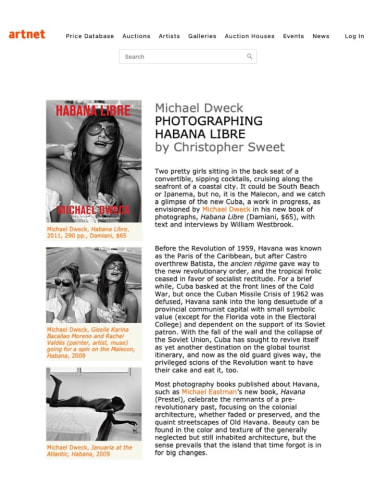Michael Dweck Photographing Habana Libre
ArtNet
12/05/2011
Back
By Christopher Sweet
Two pretty girls sitting in the back seat of a convertible, sipping cocktails, cruising along the seafront of a coastal city. It could be South Beach or Ipanema, but no, it is the Malecon, and we catch a glimpse of the new Cuba, a work in progress, as envisioned by Michael Dweck in his new book of photographs, Habana Libre (Damiani, $65), with text and interviews by William Westbrook.
Before the Revolution of 1959, Havana was known as the Paris of the Caribbean, but after Castro overthrew Batista, the ancien régime gave way to the new revolutionary order, and the tropical frolic ceased in favor of socialist rectitude. For a brief while, Cuba basked at the front lines of the Cold War, but once the Cuban Missile Crisis of 1962 was defused, Havana sank into the long desuetude of a provincial communist capital with small symbolic value (except for the Florida vote in the Electoral College) and dependent on the support of its Soviet patron. With the fall of the wall and the collapse of the Soviet Union, Cuba has sought to revive itself as yet another destination on the global tourist itinerary, and now as the old guard gives way, the privileged scions of the Revolution want to have their cake and eat it, too.
Most photography books published about Havana, such as Michael Eastman’s new book, Havana (Prestel), celebrate the remnants of a pre-revolutionary past, focusing on the colonial architecture, whether faded or preserved, and the quaint streetscapes of Old Havana. Beauty can be found in the color and texture of the generally neglected but still inhabited architecture, but the sense prevails that the island that time forgot is in for big changes.
Michael Dweck, however, elaborates on the possibilities in store by focusing, largely in black and white, on a Cuban social realm virtually unknown to outsiders. On his first visit to Cuba in 2009, Dweck stumbled into a farandula, or clique, of artists, writers, musicians and models -- members of what Dweck calls the “privileged creative class” of Cuba -- which included a few of the sons of the superstars of the Revolution (Camilo Guevara and Alex Castro, both of whom are photographers).
In this world Dweck was welcomed and given carte blanche to capture their charmed lifestyle in a seductive array of images. Disregarding the old saws of the anti-communists and the picturesque yet derelict architecture, vintage cars and widespread poverty, Dweck depicts a sensual, youthful and creative way of life that belies the dour image of the conventional view. Here, Cuba is a world of sexy encounters.
The book echoes in some ways Dweck’s first book, The End, Montauk, L.I. (2004), in that plenty of pulchritude is prancing about, along with a few satyrs, at a rather exclusive party by the sea that is about to be crashed. Yet, in the Cuban context, trouble underlies this vision, in that one feels too much history is elided in favor of the new breed of party animal. And the glamorous picture has something of déjà vu written all over it as well.
Cuban destiny aside, however, Dweck’s images dazzle. An exhibition of photographs selected from both The End and Habana Libre opens at Staley-Wise Gallery in New York this week.
CHRISTOPHER SWEET is senior photography specialist at artnet auctions and wrote the introduction to Michael Dweck’s Mermaids (2008).